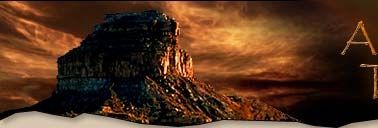Timeless Knowledge Lesson Plans
Sun-Earth Day 2005: A Special Day In Your Classroom
This activity is an opportunity to explore observations of the Sun in the past and present. You will be introduced to a variety of images, ideas and the new NASA Connect program, "Ancient Observatories, Timeless Knowledge". This particular NASA Connect program is not just about math! It also includes Science, Geography, History, Cross-Cultural Connections and Technology.
Technology Through Time Bulletin Board Activity
This bulletin board activity is designed to focus student attention on the role that sun watching has played in humankind's survival through time. As part of this display you may wish to use your own world map ordownload one we have created for you.
Ancient Observatories: Timeless Knowledge Activities
These activities are designed to help you make connections between events in your life and the seasons of the year. One major connection relates the concept of the seasons to past observations.
Building a Simple Sundial
This activity from NASA's Marshal Space Flight Center will show you how to construct a working sundial of your own!
Visit Spanish Resources to view this activity (Construyendo un Reloj Solar) in Spanish
Making a Sun Clock
Let the Exploratorium show you how to build a working Sun Clock.
Sunbeams and Sundials
Enjoy this unit based on the Space and Time gallery at the Liverpool Museum, with both formal and informal activities.
The Maya Astronomy Page
"Learn about these accomplished early astronomers. This site is concise, clearly written, and easy to navigate. It's a great starting point for exploration into the fascinating culture of the Maya." (Selected by the Exploratorium as a Cool Site in Feb. 1998)
Astronomy of the Americas: Volume 11 Planetarium Activities for Student Success (PASS)
There are hundreds of Native American cultures, each with distinctive views of the heavens. In this program, students visit five cultures: the Hupa people of Northern California, Medicine Wheel in Northern Wyoming, Chaco Canyon in New Mexico, the Mayan people and the Incan people.
Sunwatchers of the Southwest
Visit this site to download the free activity guide, "Sunwatchers of the Southwest". This guide focuses on the ancient Chaco Canyon culture and the solar observation activity their skywatchers apparently engaged in. Please note that this is the pilot version. It will be updated pending piloting feedback.
General Sun-Earth Connection Lesson Plans
All About the Sun
From NASA's Quest's Learning Technologies Channel (at NASA Ames) and the Stanford Solar Center, learn more about the sun from this impressive archive of video clips and materials from past webcasts.
Solarscapes: Sunspots and Rotation
You and your middle-school students will open up the Sun and explore phenomena most people have never seen before. Your students will calculate the period of the solar cycle and predict its shapes, and calculate the rotation period of the Sun.
Seeing the Invisible: Teacher Guide
This teacher's guide and student workbook provide you and your students with an opportunity to prove the existence of ultraviolet and infrared radiation coming from the Sun.
Seeing the Invisible: Student Workbook
This teacher's guide and student workbook provide you and your students with an opportunity to prove the existence of ultraviolet and infrared radiation coming from the Sun.
Solar Storms and You
This series of six workbooks contains a variety of SUNsational, integrated, multidisciplinary activities for grades 7-9. I was produced by the IMAGE/POETRY Teacher and Students' Consortium.
Solar Flip Book
Students will make a flip book that shows the progression of two solar events on reversible sides of the flip book. Event choices include the sunspot cycle, differential rotation of the sun using sunspots, a total solar eclipse, progression of a coronal mass ejection, and a sungrazing comet.
Build a Spectroscope
Have your students build a working spectroscope to the study the nature of light. Recommended for students grade 5 and over.

